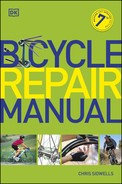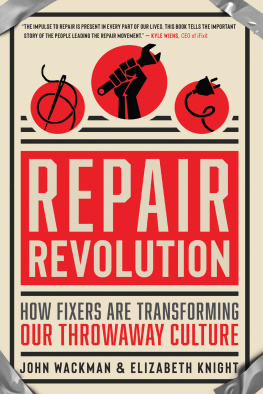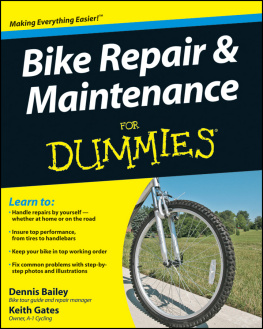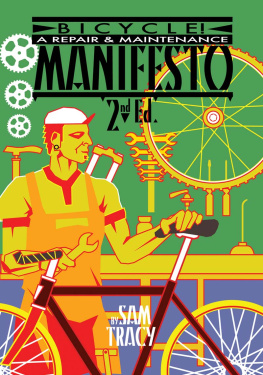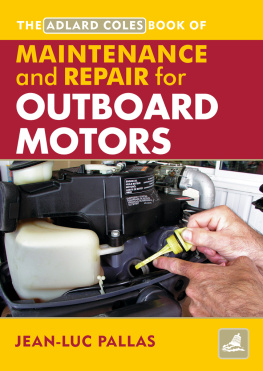


Library of Congress Cataloging-in-Publication Data
Shanks, Daimeon, 1980-
Essential bicycle maintenance & repair / Daimeon Shanks.
p. cm.
ISBN 978-1-4504-0707-6 (soft cover) -- ISBN 1-4504-0707-2 (soft cover)
1. Bicycles--Maintenance and repair--Handbooks, manuals, etc. I. Title.
TL430.S48 2012
629.28'772--dc23
2012004823
ISBN-10: 1-4504-0707-2 (print)
ISBN-13: 978-1-4504-0707-6 (print)
Copyright 2012 by Daimeon Shanks
All rights reserved. Except for use in a review, the reproduction or utilization of this work in any form or by any electronic, mechanical, or other means, now known or hereafter invented, including xerography, photocopying, and recording, and in any information storage and retrieval system, is forbidden without the written permission of the publisher.
The web addresses cited in this text were current as of March 2012, unless otherwise noted.
Acquisitions Editor: Tom Heine
Developmental Editor: Laura Floch
Assistant Editor: Elizabeth Evans
Copyeditor: Erin Cler
Permissions Manager: Martha Gullo
Graphic Designer: Bob Reuther
Cover Designer: Keith Blomberg
Photographer (cover): Neil Bernstein
Photographer (interior): Human Kinetics
Photo Asset Manager: Laura Fitch
Visual Production Assistant: Joyce Brumfield
Photo Production Manager: Jason Allen
Printer: United Graphics
Human Kinetics books are available at special discounts for bulk purchase. Special editions or book excerpts can also be created to specification. For details, contact the Special Sales Manager at Human Kinetics.
Printed in the United States of America 10 9 8 7 6 5 4 3 2 1
The paper in this book is certified under a sustainable forestry program.
Human Kinetics
Website: www.HumanKinetics.com
United States: Human Kinetics
P.O. Box 5076
Champaign, IL 61825-5076
800-747-4457
e-mail:
Canada: Human Kinetics
475 Devonshire Road Unit 100
Windsor, ON N8Y 2L5
800-465-7301 (in Canada only)
e-mail:
Europe: Human Kinetics
107 Bradford Road
Stanningley
Leeds LS28 6AT, United Kingdom
+44 (0) 113 255 5665
e-mail:
Australia: Human Kinetics
57A Price Avenue
Lower Mitcham, South Australia 5062
08 8372 0999
e-mail:
New Zealand: Human Kinetics
P.O. Box 80
Torrens Park, South Australia 5062
0800 222 062
e-mail:
E5443
T he world of professional cycling is a tense one. Inside the peloton a mistake of 1 inch can mean many trips to the hospital. A fractional error in tactics can mean the loss of the most important of races. A minute mistake in management can mean the loss of a multimillion-dollar sponsor. Most of this high-stakes tension plays out in the press and on TV screens across the world for all viewers to pontificate on. However, the one element that causes more tension inside a team, behind the curtains, and outside public view is the mechanical side of cycling.
Cycling, by nature, is a unique combination of human and machine. If the human breaks, no race can be won. However, the same is true for the machine. Much is spent on perfecting training, nutrition, and physical therapy techniques to keep the human engine from breaking. But unbeknownst to most, just as much effort is spent on ensuring the machines dont break. Mechanics for professional cycling teams must be absolutely precise in their work, because any flaw could mean a loss of millions of dollars for the sponsor and team. Even the small mistake could cause a failure leading to a crash, injuries, and even death. To say their work inside a team is important is an enormous understatement.
The riders at the professional level put the bike through stresses most do not, all the while demanding the lightest equipmentwhich sometimes makes it fragile and prone to breakage. The riders must trust the work thats been done on their bikes, beyond a doubt, so they can get on with their high-speed work. Its a tightrope, and few mechanics can take the pressure of walking itall this while being asked to live in hotels year round and improvise when proper replacement equipment cant be found on the never-ending road. The pressure the mechanic crews live under is every bit as intense as that of the riders, and they take their work every bit as seriously. You may not get to see them on TV, but no team is ever a winning team without a top wrench.
Daimeon Shanks came to my professional team while it was still a growing and blossoming dream. We were far from the best, the largest, or the best funded back then. As with any small start-up, the hurdles were numerous and the hours were very long. Despite still being a scrappy start-up, mainly based on hope rather than results or real organization, we were given an invitation to the inaugural Tour of California in 2006. However, unlike the largest pro teams, we were low on the sponsorship totem pole when it came to delivery times for our equipment. We had received our shipment of new bikes and parts just a few days before the biggest event of this small teams brief history. Our sponsors demanded that we use the new equipment, and not any from the year before, so we were faced with the task of building all the bikes up for an entire team in such a short time. And my other mechanic had just quit in frustration. I had one person to rely on: Daimeon Shanks.
Daimo, as we all knew him, was an angst-filled young wrench with a lot of ambition and drive. That much was obvious to me, right from the start. Whether or not his unique energy could be precise enough for the high-stakes game of professional cycling remained to be seen, but he was all I had in that moment. Over the next few days, he worked 24 hours a day, literally, building and tuning every one of our bikes. His bloodshot eyes still smiled because he was doing what he loved, and the challenge of doing something no other mechanics could do in the pro peloton appealed to him in some sort of sadistic way. By the start of the race, all the bikes were built.
Now, its one thing to have put all these bikes together in such short time; its quite another to have them actually work. No mechanic Id ever met (or met since) could accomplish this as a solo act. My assumption was that the first day of the race would be riddled with shifting problems, bolts coming loose, and maybe even a rolled tire. So, with crossed fingers of both hands on the steering wheel, I drove behind stage 1 of the Tour of California, waiting for disaster. Twenty miles passed with no problem, then thirty, then halfway.... We made it to the end of stage one without even a complaint from a single rider. I was amazed and forever indebted to Daimo.
Jonathan Vaughters
Former racer and current manager of the Garmin-Barracuda professional team
I would like to thank my parents for their support and understanding of my passion for cycling; Dave Campbell, my first teacher of all things cycling; Jonathan Vaughters for taking a chance on me; Tom Danielson and my business partner and best friend, Nick Legan, for their praise; Mike Friedberg for inspiring me to become an author; and Flora Duffy for putting up with my hectic schedule.
Next page
![Shanks Essential bicycle maintenance & repair: [step-by-step instructions to maintain and repair your road bike]](/uploads/posts/book/235248/thumbs/shanks-essential-bicycle-maintenance-repair.jpg)


